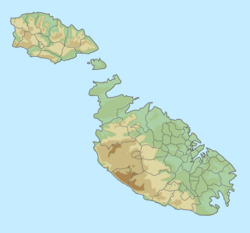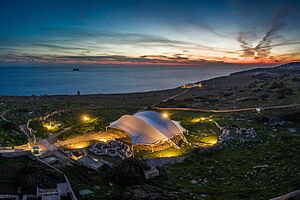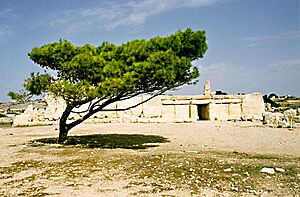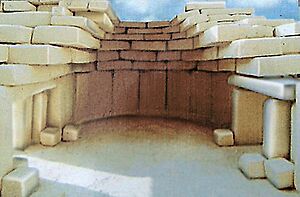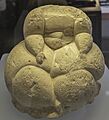Ħaġar Qim facts for kids
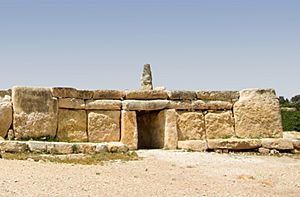
Facade of the main temple of Ħaġar Qim, seen prior to the 2009 construction of a protective shelter
|
|
| Location | Qrendi, Malta |
|---|---|
| Coordinates | 35°49′40″N 14°26′32″E / 35.82778°N 14.44222°E |
| Type | Temple |
| History | |
| Material | Limestone |
| Founded | c. 3700 BC – c. 3200 BC |
| Periods | Ġgantija phase |
| Site notes | |
| Excavation dates | 1839–1954 |
| Archaeologists | J. G. Vance Antonio Annetto Caruana Themistocles Zammit Thomas Eric Peet John Davies Evans |
| Condition | Well-preserved ruins |
| Ownership | Government of Malta |
| Management | Heritage Malta |
| Public access | Yes |
| Website | shows information about Hagar Qim |
| UNESCO World Heritage Site | |
| Part of | Megalithic Temples of Malta |
| Criteria | Cultural: (iv) |
| Inscription | 1980 (4th Session) |
| Extensions | 1992, 2015 |
| Area | 0.813 ha (87,500 sq ft) |
Ħaġar Qim (pronounced Haj-ar Eem) is an ancient stone temple complex on the island of Malta. It was built a very long time ago, between 3600 and 3200 BC. This makes it one of the oldest religious places on Earth!
The UNESCO has called these temples "unique architectural masterpieces." In 1992, Ħaġar Qim and other Maltese temples became World Heritage Sites. A famous archaeologist named V. Gordon Childe visited Ħaġar Qim. He said he had never seen a place as old as this one, even after visiting many ancient ruins around the Mediterranean Sea.
The people who built Ħaġar Qim used a type of rock called globigerina limestone. This stone is soft, so the temple has worn down a lot over thousands of years. To protect it, a large tent-like shelter was built over the temple in 2009.
Contents
About Ħaġar Qim
The ancient temple complex of Ħaġar Qim is found on the southern side of Malta. It sits on a ridge made of soft globigerina limestone. This type of limestone covers about 70% of the island. The builders used this local stone for the entire temple.
The front of the temple has a special entrance with three large stones, called a trilithon. It also has a low outer wall and tall standing stones. There is a wide open area in front of the temple. A passage goes through the middle of the building, following a special ancient Maltese design. Another entrance leads to four separate rooms.
Some parts of the temple's design suggest it was used for special ceremonies. An altar with a curved top might have been used for offering animals. Some people also think that special doorways inside the temple were used by oracles, who were thought to give advice from the gods. Archaeologists also found decorated pottery here. You can see the best examples at The National Museum of Archaeology.

No human bones have been found in or around Ħaġar Qim. This means it was not a burial site. However, bones of many animals that were offered have been found. Experts believe Ħaġar Qim was built in three main steps. First, the northern part, then the 'New Temple,' and finally the whole structure was finished.
A short distance from the temple, you can find one of the old watchtowers built by Grand Master Martin de Redin. It is called Ħamrija Tower. There is also a memorial nearby for General Sir Walter Congreve, who was the Governor of Malta. The village of Qrendi is about two kilometers southwest of the temple.
Temple Design
The Ħaġar Qim complex includes a main temple and three other large stone structures next to it. The main temple was built between 3600 and 3200 BC. However, the northern ruins are much older. The main entrance leads to an inner passage that connects six large rooms. The right side of the temple has an arch built to keep the tall stones from falling. The outer wall is made of huge upright blocks, making the building very strong.
Ħaġar Qim has a similar basic design to other famous Maltese temples like Mnajdra, Tarxien, and Ġgantija. They all have an open area in front, a main entrance, long oval rooms, curved spaces, and a central passage connecting the rooms. This shape is often called "trefoil" because it looks like a three-leaf clover. Some also think the temple's shape might copy the sacred statues found inside.
Temple Forecourt
In front of the temple's outer wall, there is a large open area paved with big, uneven stones. This area is very solid and has large blocks that were once part of walls or rooms. One of the paving stones has a hole through it. Some think this hole might have been used as a fireplace. The forecourt at Ħaġar Qim is much like the one at the southern temple of Mnajdra.
Dwelling Areas and Wall
A group of medium-sized stones form small, curved areas. These are sometimes called "dwelling-houses" or living spaces. Next to these, four rectangular stone blocks, about two feet thick, create a rectangular area with an entrance in one corner.
A strong wall, called a bastion, stands next to the temple. It is built from large stone blocks. Its western wall is about 20 meters long and curves towards the main temple and an outdoor shrine. Some believe this wall was built to protect the complex from wild animals, which were common back then. It also helped show that the temples were special, sacred places.
The front of Ħaġar Qim has the largest stone used in all Maltese ancient buildings. It weighs 57 tons! This tall standing stone, called a menhir, is 5.2 meters (about 17 feet) high. The outer southern wall has been worn down by sea winds because the tall standing stones are exposed. Over thousands of years, the temple has suffered a lot from weather and its surface has flaked off.
Northern Temple
The northern temple is the oldest part of Ħaġar Qim. It has an oval room with a curved space on each side. After a second doorway, there is another room with similar curved spaces.
The northern temple is special because it has three layers of flooring. The top layer of pavement does not show signs of fire, unlike the lower floors. Because the stone was polished differently on each layer, experts think these three layers show three big changes in how Ħaġar Qim was built.
You can find stone balls of different sizes along the walls of the northern temple and other parts of the building. People think these were rollers used to move the huge stones. When archaeologists dug, they found such rollers buried under the large stones, which helped create a strong base.
First Recess - Northern Temple
The first curved space in the Northern Temple has a round stone pillar and a rectangular stone slab standing upright in front of it. On top of the slab are round hollows. These might have been used to hold small jars for pouring out liquids as offerings. Jars found at the site have a special oval base, designed to stand upright when placed in these hollows.
You can still see parts of the upright blocks that once stood on either side of this space. To the right of this room is another curved space with a special opening called the "oracle hole." Sound could pass from the main room into this space and back again. This hole is also linked to the position of the sun during the Summer solstice. On the right side of the room, there is a flat stone block that might have been used as a seat.
Main Temple
Beyond the temple entrance is a large oval area. It is 14.3 meters (about 47 feet) long and 5.5 meters (about 18 feet) wide. Its walls are made of large stone slabs, which originally had more layers of stone on top. Two tall stone slabs with rectangular openings separate the two curved ends from the central court. These openings might have had curtains to control who could enter the side areas.
The central area has smooth, well-placed paving stones. Along the walls are low stone altars, which once had small carved marks. Some of these stones are discolored from fire. In 1839, archaeologists found important items in this court. These items, now in the Valletta Museum, include stone statues, a detailed altar stone with carvings of plants, a stone slab with spiral designs, and a moved threshold stone.
The right-hand curved area might have been used to keep animals. The left-hand curved area has a tall altar made of three stones on its left, and two more on the right, with one in a smaller room. Another room beyond this combines a central court, a small curved space, and a right-hand curved area.
The Niche
A doorway leads into a small enclosed area. This area has many small carved marks and is flanked by uniquely shaped stone altars with rounded, raised edges. The bottom of one altar has two oval holes, one above the other.
The entrance to this enclosed area is well-paved and neatly lined with upright slabs. A threshold is made of two cone-shaped pits connected at the top. These are like the "rope holes" seen in many other Maltese temples. Heavy slabs form a small curved space, called a niche, to the left of the entrance. To the right, a small room holds an altar made from a single stone block, deeply stained by fire. This space is thought to have been the most sacred part of the temple.
At the front of this enclosed area, the passage widens into a square space with a special room at the end. A slab, 0.9 meters (about 3 feet) high, blocks the entrance to this room at floor level. Another slab rests on two pillars. This design makes the whole section look like a rectangular window. Beyond this opening, there is a small room. The first people to dig here did not clearly report what they found in this space. However, comparing it to the Tarxien Temples, it is believed to have contained bones of offered animals and broken pottery used in rituals.
The Watering Place
Il-Misqa (which means "the watering place") is a flat area of bare rock on a nearby hill. It has seven bell-shaped reservoirs, which are like wells. Five of these still hold water after normal rainfall. The two wells that no longer hold water are the deepest. They are connected underground. A large stone stands over one of the dry holes, and it is thought to have been used to draw water from the well. There is an eighth well, but it is blocked by a large fig tree.
Channels cut into the rock surface direct rainwater into the wells. The water level in each well stays connected to the well next to it.
Discoveries and Care

In the 1600s, a Maltese historian named Giovanni Francesco Abela wrote that the ruins of Ħaġar Qim showed that the first people in Malta were "Giants."
Ħaġar Qim was first explored in 1839. J. G. Vance of the Royal Engineers made a plan of the buildings. He sent a stone altar, a decorated slab, and seven stone statues to Valletta. These items are now in the Valletta Museum.
More digs happened in 1885 by A. A. Caruana. He published a long report with detailed plans. In 1909, Themistocles Zammit and Thomas Eric Peet did more excavations. Later, the British School at Rome continued the work to find all the ruins in the area.
In 1910, the fields around the temple were searched carefully. The ruins themselves were precisely mapped. Some damaged parts were fixed. Many pieces of pottery, stone tools, and other objects were found. These are now in the Valletta Museum.
The temple was added to the Antiquities List in 1925.
On September 17, 1949, three small statues and parts of a much larger stone statue were found buried under a rectangular stone. The famous "Venus of Malta" statue was found on March 31, 1950. This statue looks similar to the Ħaġar Qim statues. The statues from Malta often do not show clear male or female features.
Not much has been done to restore the temple itself, except for strengthening or replacing some stones in the 1950s. Ħeritage Malta has built shelters to protect the temples from further damage by weather. A visitors' center has also been built near the temple. It has an auditorium for a video introduction and an exhibition area. Here, you can see artifacts and copies from the Museum of Archaeology, along with interactive displays.
Gallery
-
The Venus of Malta
See also
- Ġgantija
- Hypogeum of Ħal-Saflieni
- List of megalithic sites
- Megalithic Temples of Malta
- Mnajdra
- Tarxien Temples


